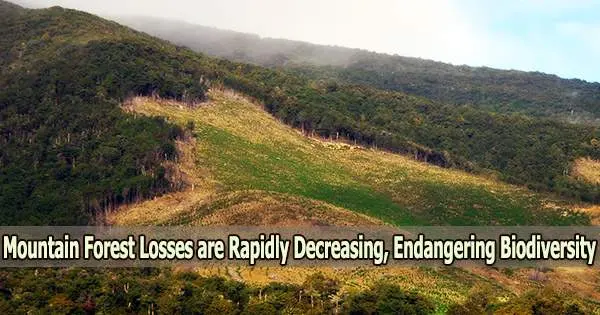Mountains are home to more than 85% of the world’s bird, animal, and amphibian species, primarily in forest settings. Yet, as reported by researchers in the journal One Earth on March 17 (2023), these forests are rapidly disappearing.
Since 2000, we have lost alpine forests covering an area greater than Texas of 78.1 million hectares (7.1%). Threatened species are coming under increasing pressure as a result of the loss, which was concentrated in tropical biodiversity hotspots.
Mountain forests were once protected from deforestation by their rough terrain, but since the start of the twenty-first century, as lowland regions have been exhausted or are under protection, they have been more exploited.
A team of scientists led by Xinyue He (@xinyue_he), Dominick Spracklen, and Joseph Holden at Leeds University in the United Kingdom, and Zhenzhong Zeng at the Southern University of Science and Technology in China wanted to investigate the extent and global distribution of mountain forest loss.
The scientists did this by monitoring annual changes in alpine forests from 2001 to 2018. They evaluated the rate of change, quantified gains and losses in tree cover, compared different elevations and mountain forest types, including boreal, temperate, and tropical forests, and investigated the effects of this forest loss on biodiversity.
Regarding sensitive species in biodiversity hotspots, the critical issue extends beyond simply preventing forest loss. We must also maintain the integrity of forests in large enough zones to allow natural movements and sufficient space for ranging species.
“Knowledge of the dynamics of forest loss along elevation gradients worldwide is crucial for understanding how and where the amount of forested area available for forest species will change as they shift in response to warming,” the authors write.
Logging was the biggest driver of mountain forest loss overall (42%), followed by wildfires (29%), shifting or “slash-and-burn” cultivation (15%), and permanent or semi-permanent agriculture (10%), though the importance of these different factors varied from region to region. The significant loss occurred in Asia, South America, Africa, Europe, and Australia, but not in North America and Oceania.
Worryingly, the rate of mountain forest loss seems to be accelerating: the annual rate of loss increased by 50% from 2001-2009 to 2010-2018, when we lost approximately 5.2 million hectares of mountain forests per year.
According to the authors, this acceleration is likely largely attributable to the rapid agricultural expansion into highland regions of mainland Southeast Asia as well as increased mountain forest logging as a result of either the depletion of lowland forests or the protection of these lowland forests.
In comparison to mountain forests in temperate and boreal regions, tropical mountain forests sustained the greatest loss (42% of the global total) and the highest acceleration rate. However, they also recovered more quickly. Overall, the researchers observed some signs of tree cover regrowth in 23% of the areas that lost forest.
Protected areas experienced less forest loss than unprotected areas, but the researchers caution that this might not be enough to preserve threatened species.
“Regarding sensitive species in biodiversity hotspots, the critical issue extends beyond simply preventing forest loss,” the authors write. “We must also maintain the integrity of forests in large enough zones to allow natural movements and sufficient space for ranging species.”
The authors also emphasize the importance of considering human livelihoods and wellbeing when developing forest protection strategies and interventions.
“Any new measures to protect mountain forests should be adapted to local conditions and contexts and need to reconcile the need for enhanced forest protection with ensuring food production and human wellbeing.”
The Southern University of Science and Technology, the University of Leeds, and the National Natural Science Foundation of China supported this research.





